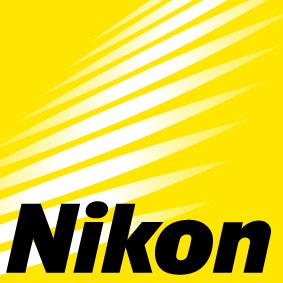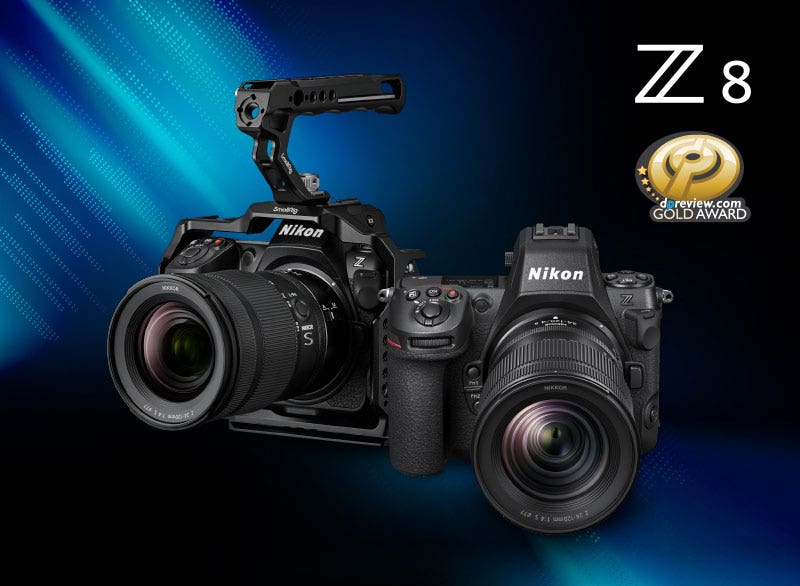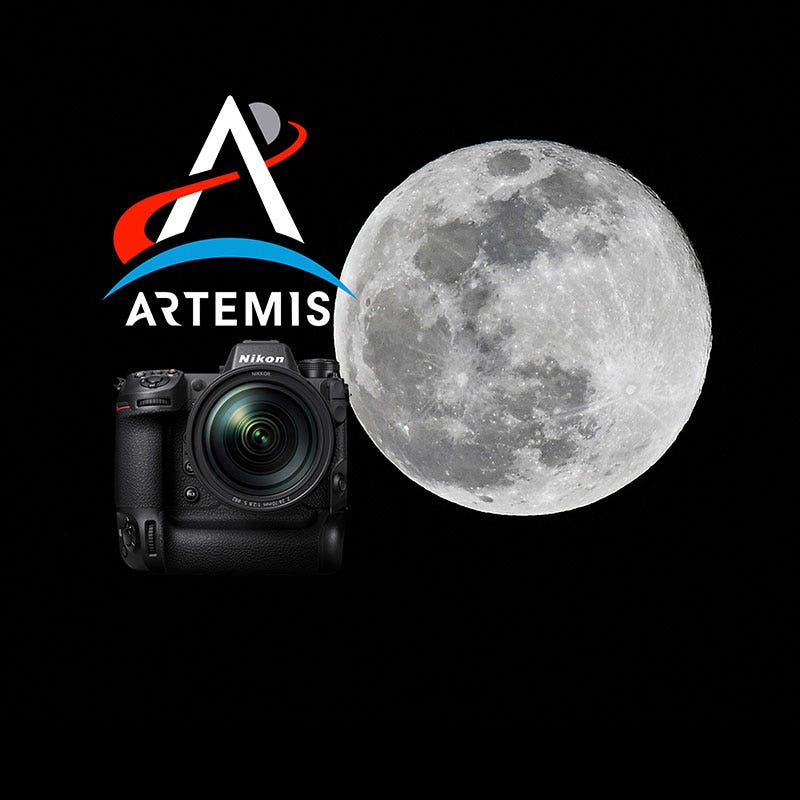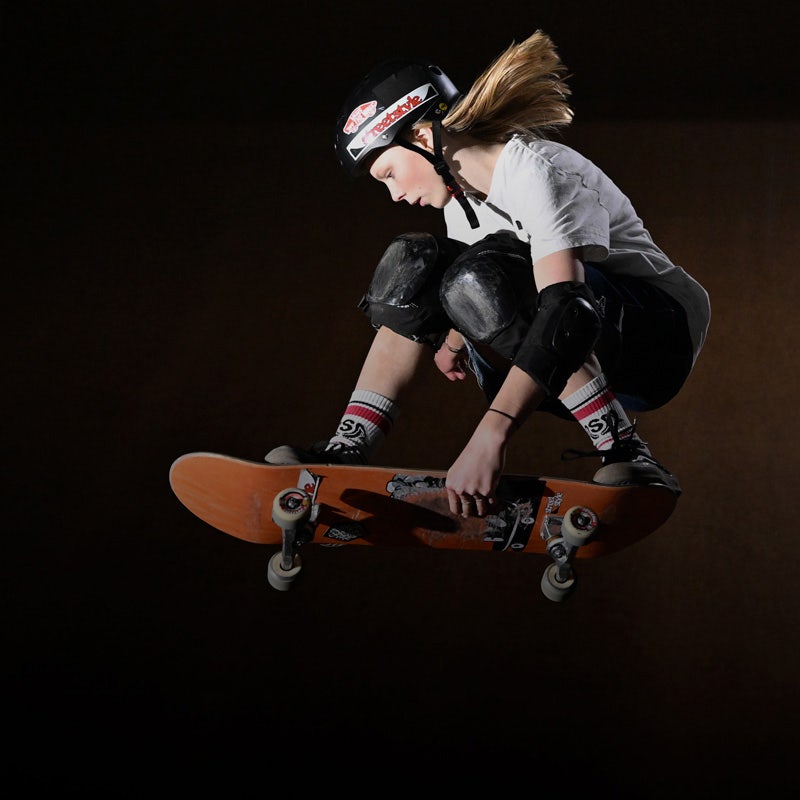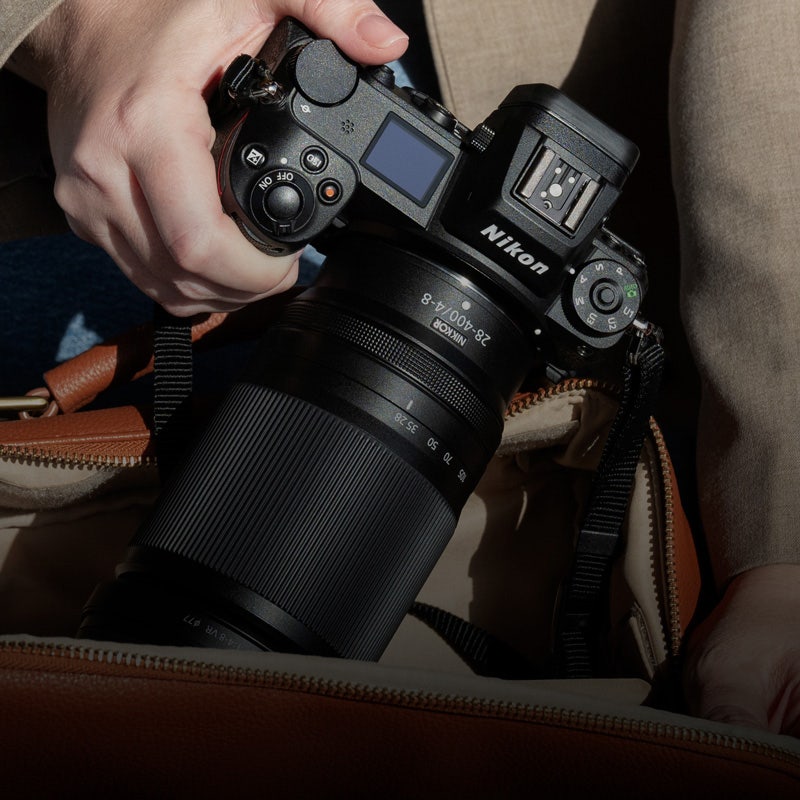

MULTIPLE EXPOSURES MADE EASY WITH NIKON Z MIRRORLESS CAMERAS
Featuring NIKON U.S. AMBASSADOR ANDREW HANCOCK
One of the more creative and expressive techniques that digital photography excels at is the multiple exposure. Back in the days of film it was much more difficult to pull off a successful double or multiple exposure. But digital has opened up so much in terms of creative options and the Z series mirrorless cameras have expanded those options even further.
"My idea for this image was to show the mind’s strength for athletes, especially endurance athletes. My model is a female Ironman competitor and she’s an exceptional athlete. To participate in such a grueling race, the mind must be incredibly strong with substantial stamina and the ability to endure suffering for extended amounts of time. To show this visually, I started off by making the frame of her riding through the studio. My assistant had to hold her bike steady so she could launch from one side of the studio, pedal twice or three times and then unclip from the pedals and stop before hitting the wall on the other side of the room. The background was lit so she would be mostly in silhouette. I used a piece of cardboard I covered with Gaffer tape to help mask the floor and put at the midpoint of the frame to only expose the top half of the frame and essentially leave the bottom half of the frame unexposed. Using the overlay feature, I shot the second image out in far west Texas and turning the camera upside down and again using the masking card I made to block off the top of the frame but still allowing for a little bit of the texture of the mountains to bleed into the tires of the bicycle." Z 6, NIKKOR Z 35mm f1.8 S lens, 1/200 second, f/9, 320 ISO for the silhouette and the Z 6, NIKKOR Z 24-70mm f/2.8 S lens at 70mm, 1/800 second, f/2.8 50 ISO for the mountain."


© Andrew Hancock
There are two different ways of creating multiple exposures using the Z series cameras: Multiple Exposure Mode and Image Overlay (which is located in the Retouch menu).
Nikon's Z series mirrorless cameras make double exposure or multiple exposure images a breeze due to the cameras’ electronic viewfinder. This is because you can now see in the viewfinder a ghosted exposure of the previous exposures as you take each new one, so placement of subjects can be more precise.


© Andrew Hancock | "The image of the hula-hooper was taken with the multiple exposure function set to lighten and taken in a block of 10 exposures as the model progressed through the frame." Z6, NIKKOR Z 50mm f/1.8 S, 1/200 second, f/6.3, 100 ISO."
USING THE MULTIPLE EXPOSURE MODE
You can record from two to 10 exposures as a single image.
To shoot multiple exposure images, you have to select the Multiple Exposure Mode which can be found in the shooting menu. Choose On (series) which lets you shoot until you turn it Off or On (single photo) that takes one multiple exposure. You also have to select the number of shots you’re planning on taking and the Overlay Mode.
The overlay mode has four options: Add, Average, Lighten and Darken.
Add: The exposures are overlaid without modification; gain is not adjusted.
Average: Before the exposures are overlaid, the gain for each is divided by the total number of exposures (the gain for each exposure is set to 1/2 for 2 exposures, 1/3 for 3 exposures, etc).
Lighten: The camera compares the pixels in each exposure and uses only the brightest.
Darken: The camera compares the pixels in each exposure and uses only the darkest.


© Andrew Hancock | "This image was taken using the Image Overlay feature. To show the cityscape growing out of the back of the head of the portrait, I first photographed a mostly silhouetted portrait with minimal light to the front of my subject. The Dallas skyline under cloud cover was photographed to expose for the buildings; letting the background get blown out to give the cutaway look to the back of the head." Z 6, NIKKOR Z 85mm 1.8S lens for both images, 1/200 second, f/5, 50 ISO for the portrait and 1/320 second, f/4.5, ISO 64 for the city."


© Andrew Hancock | "This image was created using the Image Overlay feature. I photographed the model in the studio on white background with slightly more exposure to his face. For the second image of the overlay I walked around downtown Dallas experimenting with various textures and mechanical elements I could find to juxtapose with the look of the model. When I found this broken electrical meter, I knew it was what I needed and they aligned perfectly." Z 6, NIKKOR Z 85mm f1.8 S lens for the portrait, with an exposure of 1/200 second, f/2.8 at 50 ISO and the meter was shot with the NIKKOR Z 24-70mm f2.8 S lens at 70mm, 1/1250 second, f/2.8 at 400 ISO."
The cameras also give you the choice to keep all of the exposures as individual files or create the multiple exposure and discard the individual exposure files.
Turning on Overlay Shooting lets you see earlier exposures superimposed in the viewfinder as you shoot.
Lastly, select first exposure (NEF) gives you the opportunity to choose the first exposure from the NEF images on your memory card.
Multiple exposures shot with an NEF (RAW) option selected for image quality will be recorded in JPEG fine L format. What this means is that each individual image will be captured as a NEF file, but the finished multiple exposure created by the camera is saved as a JPEG fine L (large) file.


© Andrew Hancock
"The mirrored cityscape could have been done in two ways with the Z6. It could have easily been taken as a multiple exposure since I took them in sequential frames. If I had done this, I would have either used lighten or average. Instead, I used the overlay feature again. The image was taken during a very hazy twilight over downtown Dallas thanks to a Saharan dust cloud that had blown across the Atlantic and filled the atmosphere across North Texas for several days. I aligned the buildings and the horizon to where I had reference points with the grid display in the EVF and the camera was on a Gitzo gimbal head and tripod. After taking the first frame, I rotated the gimbal so the camera was upside down, realigned the composition to match the first image and took the second frame to use for the mirror reflection." Z 6, NIKKOR Z 24-70mm f2.8 S at 38mm focal length, 2 seconds, f/2.8, 50 ISO."
When shooting multiple exposures, within the i Menu, you can view progress, retake the last exposure save and exit or discard and exit. To access these options, press the play button and then the i button.
View progress: View a preview created from the exposures recorded to the current point.
Retake last exposure: Retake the most recent exposure.
Save and exit: Create a multiple exposure from the exposures taken to current point.
Discard and exit: Exit without recording a multiple exposure. If On is selected for Keep all exposures, the individual files will be kept.


© Andrew Hancock | "With the smoke image, my assistant and I set off smoke grenades utside of the studio one afternoon between models. Using a white background and variety of colors, we shot until we had enough exposures that I was content that we had what we needed. For the second shot, I had the model split open a set of curtains we hung in the studio while lighting the background which would provide the necessary canvas for the smoke exposure. This was done using the Image Overlay feature." Z 6, NIKKOR Z 85mm f/1.8 S, 1/2500 second, f/8 at 800 ISO for the smoke. The portrait was captured using the same lens, with an exposure of 1/200 second, f/4, 100 ISO."


© Andrew Hancock |"For this image with the cow and downtown, I was again exploring how to combine opposite elements into one cohesive frame. Knowing I had enough skyline photos that would afford me options in how l could use them in an Image Overlay, Thit the road and traveled through the central Texas hill country on my way to the Big Bend region of far West Texas. On my journey I passed this cow in the field and decided to stop. The way the trees were situated in the field, I knew that they could play well to the buildings on the cityscape that was on the media card." Z 6, NIKKOR Z 24-70mm f/2.8 S lens at 70mm focal length for the cityscape with an exposure of 1/3200 second, f/3.2, 160 ISO and the cow in the trees was photographed with the NIKKOR Z 85mm f/1.8 S lens with an exposure of 1/1600 second, f/1.8, 50 ISO."
IN-CAMERA IMAGE OVERLAY
The Image Overlay feature lets you create double exposures but it works in a different way. The in-camera Image Overlay lets you choose any two images taken with the same camera that are saved on your media card to be combined in-camera. Combine images that were taken weeks apart and you can choose any images on the media card.
To get started, go to the Retouch menu. Toggle down and choose Image Overlay. Now choose Image 1, and scroll through the images on your media card to find the first shot. Then choose Image 2, and select Overlay. The two images will be combined in camera, and saved as a JPEG file on your media card.
The combinations are limitless. You can even keep a media card with images of a full moon or some other subject handy and when you come across a scene or subject that would work as a double exposure, simply use that media card and experiment!
